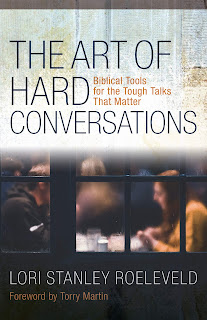TITLE:
The Art of Hard Conversations: Biblical Tools for the Tough Talks That Matter
AUTHOR: Lori Stanley Roeleveld
PUBLISHER: Grand Rapids, MI:
Kregel Publications, 2019, (240 pages).

It has been said that talk is easy. It's the walking that's hard. Truth is, there are times in which talk is hard. How do we open up a conversation in times of trouble? There are significant barriers that come up during such moments. Why then is it hard? Author Lori Stanley Roeleveld writes that: "Barriers arise around tough talks because our enemy knows they're a spiritual front line." By calling it the "art" rather than the science, we get a glimpse of where the author is coming from. We may have all the techniques and strategies on approaching talk conversation. That may work for computers and straight-talk with the direct. However, emotions change. People change. Circumstances change. That is why we need a variety of ways in which to approach different situations which carry various levels of difficulties. This art includes many different aspects. As a language art, we work with words, silence, timing, and body language. As a martial art, we learn that conversations are key ways to deal with conflict, growth, relationships, and people to people communications. As a sacred art, we see conversations as a way to channel our attention to God. Roeleveld gives us ARTwork:
- Answering a thought question;
- Reading relevant Scripture
- Trying a new conversational tool.
The way to begin is to understand the place of perspectives and personalities. People have different perspectives that come up at different situations and emotional moments. Sometimes, it takes a shocking opening line like what the author did with her father. At all times, we need to discern what the thought question is and how to reframe an appropriate opening line. After an introduction to the conversational idea and concept, we get a chance to practise the art. Each unit of study contains three to five lesson plans to guide us through. Lessons such as the three different types of communication styles. The "Swooping Hawks" style reminds us to be "praying people" instead of "preying people." The "Retreating Turtles" style shows us that we could easily retreat from tough conversations, but when it comes to tough talk, sometimes the most loving thing to do is to stick out necks out. The "Camouflaged Chameleons" modify their styles without compromising the message. Throughout the book, the author uses these three animals to describe the different characteristics and approaches to resolving hard conversations. They all possess different kinds of walls. Understanding their personalities would greatly aid in building communication bridges. Failure to do so would make any hard conversation even more difficult.
Each lesson begins with a biblical passage to set the stage for illumination and reconciliation. We learn that the key to a good start is to know who we are dealing with. More importantly, it is to know ourselves and our own heart's motives. One big reason why hard conversations never really take off is because of the lack of hope in seeing success. A huge tip the author provides is the list of six questions.
- What’s my point?
- What do I know about the other person?
- What emotions may be involved in this conversation?
- What biblical guidelines exist for this conversation? (Is it based in truth?)
- Is this conversation grounded and timed in love?
- What’s my plan for following up either success or rejection?
She follows up with a detailed description of each question to help us understand ourselves prior to entering any difficult conversations. In the final part of the book, we get a lot of helpful examples on how to put these things to practice.
My Thoughts
We live in a world where most people would either choose to fight to win or take flight to avoid losing. The former puts one's agenda more important over others while the latter avoids any confrontations altogether. Fighting is good but one needs to know how to fight fair and to fight well. Taking flight may sometimes be necessary but not all the time. We need to find a way to navigate the in-betweens, and to know how to engage well and constructively. Fighting without loving could damage relationships. Fleeing without engaging could make us miss out on an opportunity to be salt of the earth. In this book, we find the way of art to engage people in the most challenging situations of life. We need such guidance all the time. Otherwise, we would forever be living superficially with superficial relationships in a superficial world.
Talk may be easy, but constructive conversations take a lot of hard work. This book shows the way in learning to build up one another. In a Church, this is an important exercise to keep practicing. In fact, the most powerful witness a Church could ever have is to cultivate a community of truth-telling. One that learns to tell the truth in love. One that is able to deal with disagreements in a mature manner. We need more testimonies of how we could all be so different, yet be able to live and accept one another as we are. Christians are called to be peacemakers and increasingly in a globally connected world, we have more opportunities to do just that. If there is any one reason to pick up this book and read, it would be from Proverbs 25:11: "
A word fitly spoken is like apples of gold in a setting of silver." May this book encourage us to do just that.
Lori Stanley Roeleveld is author, speaker, and calls herself a "part-time giant slayer." She received her education on Biblical Studies and Psychology from Barrington Christian College. Her website is
here.
Rating: 4.5 stars of 5.
conrade
This book has been provided courtesy of Kregel Publications and NetGalley without requiring a positive review. All opinions offered above are mine unless otherwise stated or implied.







